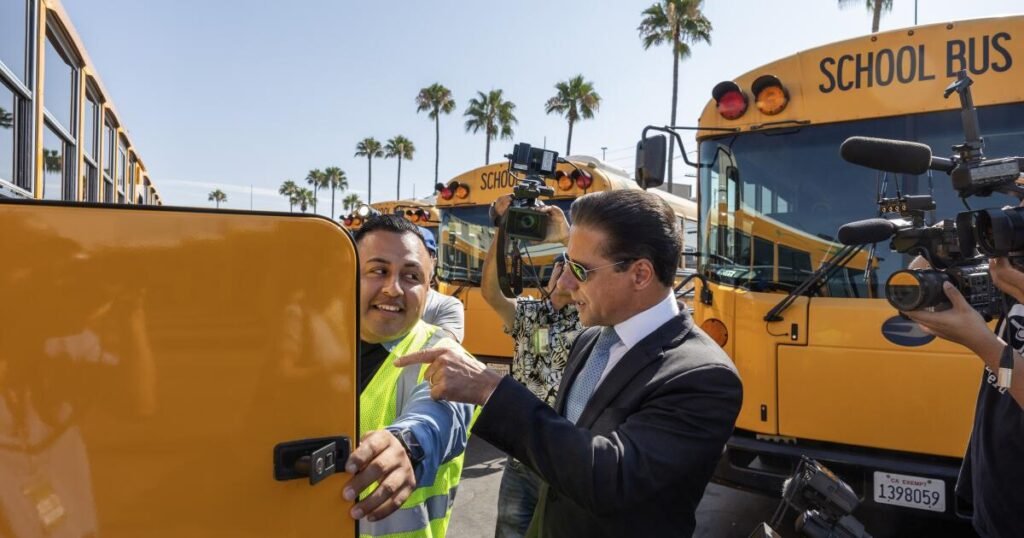Los Angeles education officials are set to decide Wednesday whether to put a $9 billion school construction bond on the November ballot, the largest in the district's history and comparable in size to the statewide $10 billion school bond measure already on the ballot.
A two-thirds majority, or at least five of the seven board members, must vote in favor, and board approval is widely expected. At least 55% of voters must vote in favor in November for the measure to pass. In 2008, voters approved a $7 billion bond for the Los Angeles area, the second-largest for any school system.
If approved by voters, the bond would increase property taxes on a median-priced home by about $273 a year, according to estimates from the Howard Jarvis Taxpayers Association.
Los Angeles school officials said in a staff report that the needs were “great, with more than 60 percent of school buildings being older than 50 years old and in dire need of renovation. This means that the majority of Los Angeles Unified School District students attend school in aging facilities that do not meet today's standards for learning and safety.”
“Despite upgrades already completed or underway, current estimates indicate there is more than $80 billion in unfunded school facilities and technology needs across Los Angeles Unified School District schools, with needs growing annually,” according to the report.
The meeting was scheduled with just 24 hours' notice, the minimum time allowed by law, as the board faced a Friday deadline to put the bond issue on the November ballot.
How will the bond funds be used?
A summary of the initiative posted Tuesday cited the need to “upgrade, modernize and replace aging and deteriorating school facilities, including school technology infrastructure and equipment.”
Goals also include “enhancing and expanding outdoor spaces and dining services for students” and promoting “energy efficiency.”
Sixteen years have passed since the nation's second-largest school system asked voters for a property tax increase to pay for facilities and infrastructure through general obligation bonds when the system was in the final stages of the nation's largest school construction program, initiated in response to overcrowding.
From the mid-1980s through the early 2000s, school systems dealt with crowding by operating year-round, but the calendar shaved nearly a month off students’ school days. The restrictive schedules also meant many students missed out on advanced coursework. Meanwhile, schoolyards became seas of asphalt broken up by portable classroom buildings.
Although the scope of the original project was scaled back due to high construction costs, the initiative enabled students to return to a regular school year and attend nearby schools, which was made possible as student enrollment began a steady decline that continues to this day.
New challenges for 2024
The current challenge is to rehabilitate the aging campus and modernize and improve classrooms and buildings.
Existing construction programs aren't even fully funded yet, leaving billions of dollars more to spend, but those funds are being used to fund higher-priority projects already in the pipeline, and officials say the number of underfunded higher-priority projects is more than enough to eat up the $9 billion being sought.
One example of the current array of projects in the works is the ongoing reconstruction of Belvedere Middle School in East Los Angeles and Roosevelt High School in Boyle Heights.
That scene could also be seen on Monday at Jordan High School in Watts, where bond funds were used to build a health clinic to serve the physical and mental health needs of families in low-income areas where medical care is scarce.
The clinic opened in 2008 but has been unable to continue operating during the COVID-19 pandemic. A new provider, UMMA Community Clinic, will take over the renovated facility.
“What we have experienced is clear evidence that what is happening in this community is not yet reality. [in] “It's the same for many other communities,” Los Angeles Schools Chancellor Alberto Carvalho said, “so we're going to continue to invest in physical infrastructure like wellness centers, air conditioning, roofs, window replacements — all the things we want to see happen in every community, and they continue to be a priority for our district and our school board.”
School districts can also use bond funds to fund projects such as the continued conversion of school buses from gasoline-powered to electric.
What about state school bonds?
Proposition 2 would allow the state to borrow $10 billion to fund repairs and renovations at thousands of public elementary, middle, and high schools and community colleges across California.
Funds from the last school bond passed in 2016 were long ago depleted, and the state's school repair fund is expected to dry up by January. Districts are on a waiting list hoping a new bond will pass and use $3.4 billion for already approved projects, including fixing harmful mold, leaking roofs and septic systems, building classrooms, modernizing science labs and replacing aging buildings.
Proposition 2 would provide $8.5 billion for facility renovations and new construction for TK-12 schools, with 10 percent going to small school districts. It would provide $1.5 billion for community colleges. If approved by a majority vote, the bond would allow lawmakers to borrow money that would be paid back over time from the state budget.
Opposition emerges
A spokesman for the Howard Jarvis Taxpayers Association expressed opposition to the Los Angeles school district bond.
“This bond will significantly increase property taxes at a time when Los Angeles homeowners are struggling with the rising cost of living, including soaring utility bills,” said Susan Shelley, the group's vice president of public affairs.
She calculated, based on the district's description of the measure's impacts, that over a 30-year period, a moderate-priced homeowner “would pay more than $8,200 in increased property taxes from this bond alone.”
She added: “With enrollment declining, taxpayers have a right to demand that school districts implement all possible cost savings before asking for further tax increases.”
The Jarvis Association also opposes state school bonds.
School board seats are also on the ballot in November, with three of the seven geographically divided seats at stake.
















